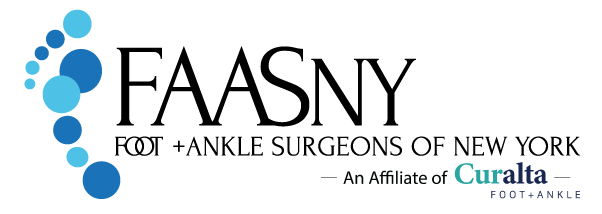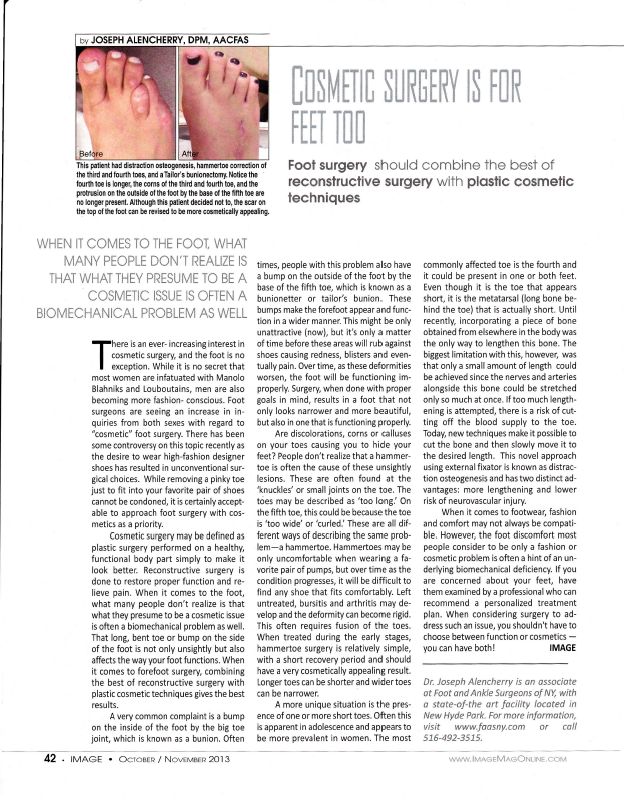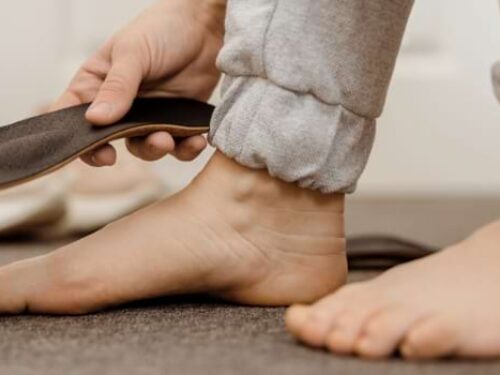
Reconstructive Foot Surgery
There is an ever increasing interest in cosmetic surgery, and the foot is no exception. While it is no secret that most women infatuate over Molono Blahniks and Louboutains, men are also becoming more fashion conscious. Foot surgeons are seeing an increase in inquiries regarding “cosmetic” foot surgery from both sexes. There has been some controversy on this topic recently as the desire to wear high-fashion designer shoes have resulted in unconventional surgical choices. While removing a pinky toe just to fit into your favorite pair of shoes cannot be condoned, it is certainly acceptable to approach foot surgery with cosmetic as a priority.
Cosmetic surgery may be defined as plastic surgery performed on a healthy, functional body part simply to make it look better. Reconstructive surgery is done to restore proper function and relieve pain. When it comes to the foot, what many people don’t realize is that what they presume to be a cosmetic issue is often a biomechanical problem as well. That long, bent toe or bump on the side of the foot is not only unsightly but also affects the way your foot functions. When it comes to forefoot surgery, combining the best of reconstructive surgery with plastic cosmetic techniques gives the best results.
A very common complaint is a bump on the inside of the foot by the big toe joint, which is known as a bunion. Often times, people with this problem also have a bump on the outside of the foot by the base of the fifth toe, which is known as a bunionetter or tailor’s bunion. These bumps make the forefoot appear and function in a wider manner. This might be just unattractive now but it’s only a matter of time before these areas will rub against shoes causing redness, blisters and eventually pain. Over time, as these deformities worsen, the foot will be functioning improperly. Surgery, when done with proper goals in mind, results in a foot that not only looks narrower and beautiful but also in one that is functioning properly.
Are discolorations, corns or calluses on your toes causing you to hide your feet? People don’t realize that a hammertoe is often the cause of these unsightly lesions. These are often found at the ‘knuckles’ or small joints on the toe. The toes may be described as ‘too long.’ On the fifth toe, this could be because the toe is ‘too wide’ or ‘curled.’ These are all different ways of describing the same problem—a hammertoe. Hammertoes may be only uncomfortable when wearing a favorite pair of pumps, but over time as the condition progresses, it will be difficult to find any shoe that fits comfortably. Left untreated, bursitis and arthritis may develop and the deformity can become rigid. This often requires fusion of the toes. When treated during the early stages, hammertoe surgery is relatively simple, with a short recovery period and should have a very cosmetically appealing result. Longer toes can be shorter and wider toes can be narrower.
A more unique situation is the presence of one or more short toes. Often this is apparent in adolescence and appears to be more prevalent in women. The most commonly affected toe is the fourth and it could be present in one or both feet. Even though it is the toe that appears short, it is the metatarsal (long bone behind the toe) that is actually short. Until recently, incorporating a piece of bone obtained from elsewhere in the body was the only way to lengthen this bone. The biggest limitation with this, however, was that only a small amount of length could be achieved since the nerves and arteries supplying alongside this bone could be stretched only so much at once. If too much lengthening was attempted one risks cutting off the blood supply to the toe. Today, new techniques make it possible to cut the bone and then slowly move it to the desired length. This novel approach using external fixator is known as distraction osteogenesis and has two distinct advantages: more lengthening and lower risk of neurovascular injury.
When it comes to footwear, fashion and comfort may not always be compatible. However, foot discomfort most people consider to be only a fashion or cosmetic problem is often a hint of an underlying biomechanical deficiency. If you are concerned about your feet, then have them examined by a professional who can recommend a personalized treatment plan. When considering surgery to address such an issue, you shouldn’t have to choose between function or cosmetics—you can have both!



